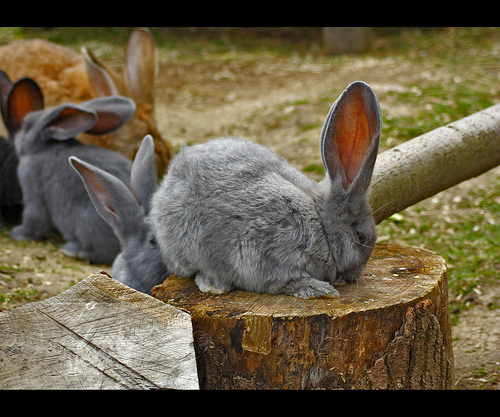Raising Meat Rabbits

In our county, 4-H members can start showing livestock at age 5, primarily chickens and rabbits. By age nine they’re usually well seasoned livestock caretakers, ready to move onto showing and selling market animals at the county fair.
When Brianne was ready to take her first pen of meat rabbits we were stumped on where to buy quality breeding stock. So, we called a local gourmet market that sold rabbit meat. Really. I explained to the meat department manager what we were doing and he was pleased to give me the name and number of their fancy meat broker. Through a series of phone calls we worked our way backwards through the broker, to the feeder and finally to the source – the breeder. After a few more calls with the breeder we were on our way to her rabbitry to buy our breeding stock.
But, not just any rabbitry, the largest in more than a hundred mile radius, with 1,000 does under cover. We had never seen anything like. This wasn’t a place for agritourism or a still shot of a Walton’s set. The neighbor’s may not have liked the stacks of cages outside or the tarpped canopies that made up the overflow area; this was a working production farm not a New England country home. It was scrappy. I loved the place, it was growing healthy food for families and gourmet markets alike. And, it was providing Brianne with her first foundation stock.
Everywhere we looked were cages filled with does and their babies (called kits). The breeder gave us the grand tour of the well thought out and efficient operation, then took us to a special area where she kept her sale rabbits. Since Brianne was in 4-H and a first time exhibitor the breeder selected two seasoned does that had kindled several times. Kindling is the term used for giving birth. They were New Zealand whites and they were big – almost 12-pounds each! More importantly, they were bred, so we didn’t need to worry about a buck, and would kindle in time to raise for our county fair.
When all was done outside we loaded our rabbits into their cages in the back of the truck and made our way inside to talk. The breeder had prepared an information sheet on how to care for our new additions and a timetable of what to do to prepare for their kindling. With the confidence that we would have a mentor we felt even more excited about becoming rabbit breeders.
The hutches at home had already been set up and stocked with food and water, ready for their new occupants to arrive. When everyone was settled in we waited for the big event – BABIES! For weeks we watched for the telltale signs, checked out the “to-do” list and readied ourselves. Then one day, out of the blue, we noticed one of the does had a pile of fur in the nesting box; a good sign that her time was near. Nearer than we thought, for the next day we found 10 wriggling babies buried deep in the warmth of their mamas fur. A day later the other doe kindled with 12 kits. Our first time out and our combined litters consisted of 22 kits!!
It had begun. We were rabbit breeders now.
Whether you’re in a city apartment, on a suburban lot or a rural farm, raising your own inexpensive (and even organic) food is within your reach. In just one year, a 10-pound doe can produce 320 pounds of meat in less than 15 cubic feet. Also check these two great book resources:
http://www.storey.com/author.php?ID=501109
http://www.amazon.com/Encyclopedia-Country-Living-Fashioned-Recipe/dp/0912365951
Recent comments
Aenean nonummy hendrerit mauris. Phasellus porta.